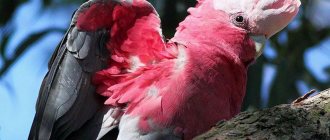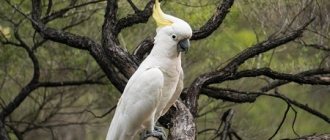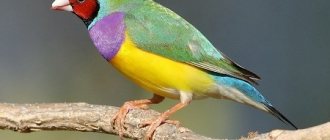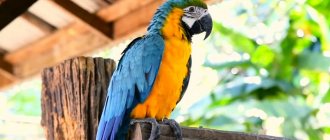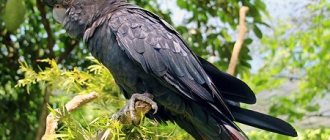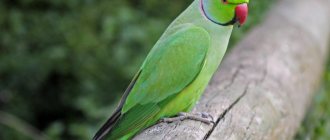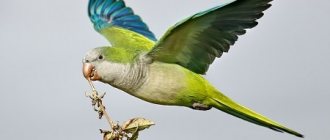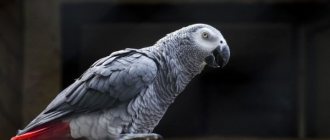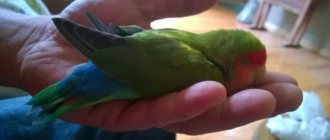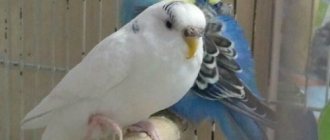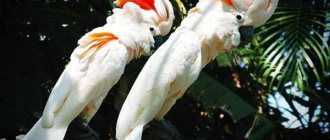The magnificent red macaw parrot is one of the most beautiful birds on the planet. This is a large parrot with bright plumage, regal bearing and piercing eyes. The Macau macaw is valued very highly, so it is quite difficult to acquire and keep this majestic bird. In captivity, macaws can be seen in zoos and circuses, as well as among lovers of exotic birds. The article describes the life of a grandiose bird in nature, the features of its character and appearance. The nuances of home maintenance are considered and information on purchasing a red macaw is provided.
Description and appearance
Macau is one of the largest macaws. Its size from the tip of its beak to the tip of its tail is almost a meter. The tail grows to 50-60 cm. The muscles are well developed, and the body is covered with wide, dense feathers. Thus, the macaw looks very powerful, but weighs about 1.5 kg.
The key color of plumage is red. These are the head, neck, body and tail. The flight feathers, outer tail feathers and undertail are blue. The wings have a dividing area of yellow feathers with blue tips. The nominate species of bird has green patches on its wings, but the macao cyanoptera variety does not. The elongated and narrowed tail straightens out in flight and looks like a chic colored fan.
A distinctive feature of all macaws is their intimidating beak. The Macao has a pinkish central part of the beak, and the tip and mandible are black. The cheek area is devoid of feathers, there is only white folded skin. The eyes are transparent yellow with a small black pupil. Chicks have completely black irises. The scaly skin on the paws is dark gray.
On a note! Red macaws are not sexually dimorphic. It is possible to determine the gender of a parrot only in laboratory conditions or with the help of a small endoscopic operation.
Lifestyle in nature
Macaws are inhabitants of the hot tropical countries of the Western Hemisphere. Their distribution area is the upper third of South America and part of Central America. The red macaw can be found in Mexico, Panama, Venezuela, Peru, and also in the Amazon River basin. Warm-loving birds prefer to settle in impenetrable thickets. For the most part, they choose tall old trees: it is easier to hide in their dense crowns, and when the nesting season begins, it is easier to find a suitable hollow.
This is interesting! Macaws' affinity for heights is explained by their lack of sense of smell. To avoid becoming prey to predators, the birds stay overnight in the upper tiers of the forest.
Red macaws lead a gregarious lifestyle. The average flock contains 100 individuals. Married couples are created within the team. Macaus feel family ties, so they interact with other species of macaws. A friendly company of blue-yellow, hyacinth, and red macaws is not at all uncommon.
The diet of a herbivorous parrot includes nuts, seeds, and fruits. With its powerful beak, the macaw easily opens the strong shell and takes out the ripe kernels with its tongue. Still, birds prefer unripe nuts and fruits. Some types of nuts accumulate selenium, the excess of which leads to intoxication of the body. Clay or river silt helps parrots neutralize the effect of this element. By breaking off pieces of soil from rocky shores and swallowing them, the red macaw receives a natural sorbent: clay components cleanse the digestive tract of toxins.
Lifestyle of Ara parrots
Most often, such parrots choose tropical forests for settlement.
For their safety and comfortable existence, birds choose tree crowns at a sufficient height.
Birds select vegetation and fruits as food, for example, nuts, fresh shoots from trees and shrubs.
During the ripening season of agricultural crops, these birds can fly and hunt from the fields, causing damage to agriculture and the final harvest.
Reproduction
The macaw parrot is considered a long-liver - in the wild, constantly exposed to danger, it can live 25-30 years. A parrot is ready to reproduce no earlier than it is 4 years old, but most often sexual maturity occurs by the age of seven. In terms of human age, this is approximately 20 years.
Macaws do not make nests in the usual sense, that is, they do not build fancy structures from branches. Parrots nest in hollows or crevices of rocks. A low-lying hollow is unlikely to please the bird, as predators can reach it. The most dangerous enemies for American parrots are snakes - they make their way to the nesting site and steal eggs. Because of this, the population size is declining, especially considering that macaws produce offspring once every two years.
Did you know? Macaws are interesting because they create stable pairs long before puberty. Birds of different sexes spend a lot of time together from a young age, become attached to each other, and only after a few years do they develop mutual sexual interest.
In red macaws, the mating season is accompanied by lengthy mutual courtship. The birds sit side by side for a long time, scratch each other’s heads, and lock their beaks together. If one of the pair flies out of the tree, the second one immediately catches up with him. Males jealously guard their mates. No one dares to drive away or otherwise disturb the mating female, otherwise he will receive a rebuff from the hot-tempered male.
Intelligence and character
Physically strong and resilient, the red macaw parrot has the appropriate character traits. A strong bird, it also shows itself to be dominant in behavior. In nature, this is noticeable by how impressively she moves and how regal she carries herself. Even the bright colors themselves indicate that the red macaw is not afraid of anything and does not need camouflage.
Love of freedom is one of the characteristics of Macau. A parrot locked in a cage will look for any way to get out. The bird can be aggressive and unpredictable. You always need to be on guard with her. An angry parrot should be left alone for several hours to calm down. It is difficult to tame a macaw, but it is quite possible if you take it into your home as a chick. And yet, many large parrots get used to people and behave kindly.
The macaw is famous for its high intelligence and is easy to train. He can perform tricks on command, sort objects, and show miracles of acrobatics. You can teach him to pronounce words only through regular training. In order for a macaw to speak, he needs to spend at least 3 hours every day. During “lessons,” you should clearly and loudly pronounce individual words that you would like to hear from your pet.
Cell
It is necessary to build perches in the cage; they serve the pet for sleeping, sitting and for sharpening its claws and beak. Fruit branches are better suited for the bird to sit on.
These birds are very active. For games and physical exercise, ladders, horizontal bars and ropes are suitable for them. All these things can be purchased at any pet store.
Video
Keeping at home
Having a macaw parrot in your apartment is a dream that is impossible for many. The loud, unpleasant voice of the red macaw is one of the negative aspects that influence the decision of the future owner. In a small room you will not be able to escape the annoying noise. To keep such a wayward, loud bird, you need to have impressive self-control.
In addition to sharp cries and unpredictable behavior, the macaw has the ability to destroy everything in its path. The bird's natural caution is dulled in captivity, but its curiosity intensifies. Having such a destructive force in the apartment in the form of a feathered pet, you cannot leave it unattended. Valuables, hazardous materials, and electrical wires should be under special control. Only a vigilant owner can protect the ward from an accident.
Arrangement of the cage
A Macau parrot, which is problematic to keep, can only be owned if there is a place to live. Whether it will be a separate room, an enclosure or an imported spacious cage is decided taking into account the capabilities of the owner.
Attention! If a parrot is given a room for sole use, it should have a cage for sleeping. The bird needs a rest area where it can hide from prying eyes and sleep.
For safety reasons, you need to choose a cage of the strongest design with a reinforced frame. A regular type of cage will not work - the red macaw with its huge beak is capable of cutting through thin wire and bending soft metals. By getting out in the absence of the owner, the parrot can spoil things, get injured, and also fly out the window and get lost. The cage must be stable so that it does not tip over due to the active actions of the macaw.
An aviary or cage for a large parrot is arranged in such a way that the pet can live comfortably and the owner can care for it comfortably. You can't do without wooden poles. Thick branches of deciduous trees are suitable as perches - they are good both for support and for grinding down beaks and claws. You should not fill the cage with a large number of accessories; it is better to make a separate playground on which the parrot will hone his skills.
Nutrition
The large parrot is fed thoroughly twice a day. A significant part of the diet consists of cereals, legumes and seeds:
- wheat;
- oats;
- corn;
- lentils;
- millet;
- sunflower.
Nuts, so beloved by wild parrots, are a rare delicacy for pets. Fatty foods should be limited, since at home parrots spend little energy and quickly gain weight. Delicious nuts in a strong shell should be a treat and a reward for success in learning.
Fresh and boiled vegetables, fruits and berries are available as an addition to the main menu:
- bananas;
- apples;
- pears;
- oranges;
- carrot;
- cucumbers;
- zucchini;
- blueberry;
- grape;
- raspberries.
It will be useful to accustom your pet to juicy greens (lettuce, celery, rhubarb). The foliage creates additional volume in the stomach and gives a feeling of fullness. In addition, greens are rich in vitamins. It is important to remember that the parrot must receive its food from its own feeder. It is prohibited to feed a bird from a common table.
Nutritional Features
Macaw macaws love to feast on fruit, so in the wild they cause significant damage to cultivated plantations. They fly several kilometers from their habitat in search of food. They prefer vegetables, nuts, juicy fruits, and berries. They love to visit pea and sunflower plantations, cereal crops, and feast on coconuts. With their prey they fly up to the top of the nearest tree and only eat it there.
In addition to fruits and nuts, they consume plant inflorescences and green shoots of trees. They do not disdain insects and larvae. Mineral salts are drawn from muddy sediments on river shallows. They help neutralize toxins from unripe fruits.
In captivity, you need to try to diversify your diet. In Russian conditions, the red macaw can be offered:
- Juicy fruits, citruses and vegetables;
- milky corn;
- dog-rose fruit;
- raspberries, blackberries and others;
- different types of nuts, chestnuts;
- Grain mixture from various cereals;
In winter, it is better to give the mixture of grains in sprouted form. In summer, you can feed spinach, dandelion grass and flowers, plantain, and grass. As a treat, you can offer porridge cooked in its pure form without salt. 2-3 teaspoons will be enough.
A separate feeder should always contain gravel, shell rock or eggshells, meat and bone meal, and chalk.
Price
It is not easy to get a red macaw - these birds are mainly brought from European nurseries. Luxurious parrots are also bred in metropolitan nurseries specializing in elite birds. The cost of a Macau hatchling chick in such organizations is 170-300 thousand rubles. The price depends on the age, gender, health and degree of tameness of the parrot. You can buy an adult macaw on the private classifieds website. However, it is worth remembering: the older the parrot, the more difficult it is to tame it.
The red macaw parrot is picky about living conditions and needs attention. It is difficult for this bird to live in captivity without communicating with people. If you raise a macaw correctly, it will become a family favorite and a source of pride. Macau are capricious, capricious and very whimsical, but they are so affectionate with the person they trust.
Story
The first part of the book “Chronicle of Peru”, (1553).
In 1553, red macaws were first mentioned in literature - in the book “Chronicle of Peru” by Pedro Cieza de Leon:
Coming from the city of Antiocha to Cartagena, when we settled it, Captain Jorge Robledo and others found so many fish that we killed with sticks whatever we wanted to catch... There are many turkeys, pheasants, parrots of various species, red macaws [guacamayas], very brightly colored .
— Cieza de Leon, Pedro. Chronicle of Peru. Part one. Chapter IX.[2]
